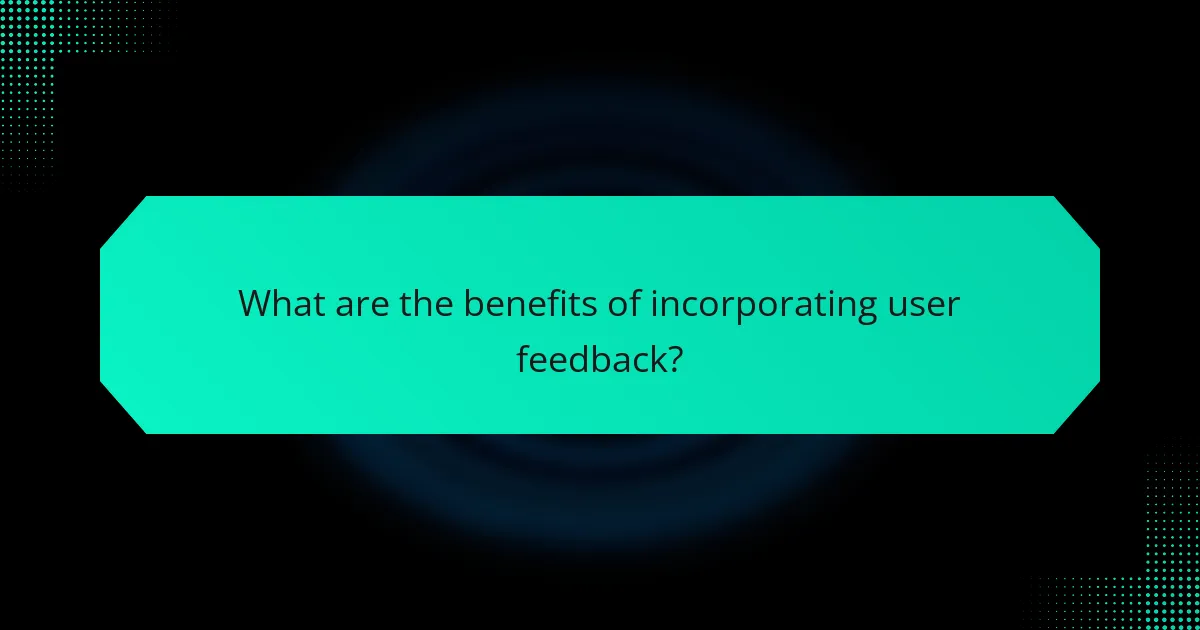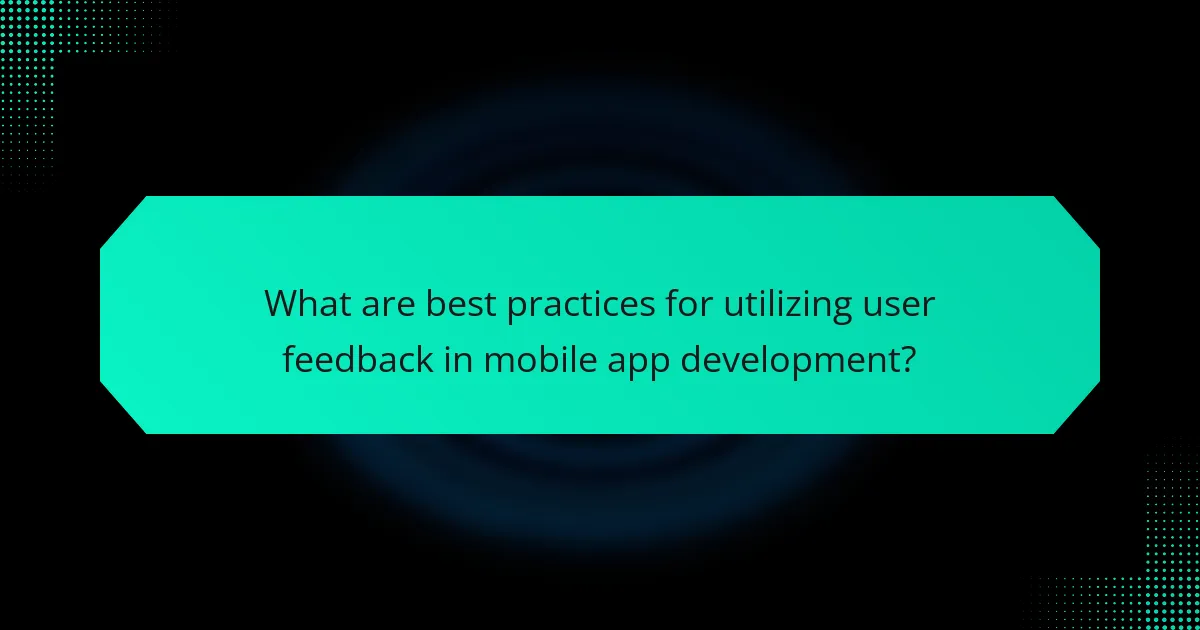User feedback is a critical component of mobile app development, serving as a guide for developers to understand user needs and preferences. Analyzing this feedback allows developers to identify bugs, usability issues, and opportunities for innovation, ultimately enhancing user satisfaction and retention. Studies indicate that apps incorporating user feedback can experience a 30% increase in user engagement. Best practices for utilizing feedback include systematic collection through surveys, prioritizing issues based on impact, and validating changes with users before full implementation. Regular communication of updates to users fosters a sense of community and loyalty, further contributing to the app’s success in a competitive market.

What is the Importance of User Feedback in Mobile App Development?
User feedback is crucial in mobile app development. It guides developers in understanding user needs and preferences. By analyzing feedback, developers can identify bugs and usability issues. This process enhances user satisfaction and retention. Studies show that apps with regular updates based on user feedback see a 30% increase in user engagement. Additionally, user feedback fosters innovation by revealing new feature ideas. Incorporating feedback leads to a product that better meets market demands. Overall, user feedback significantly improves the app’s quality and success.
Why is user feedback critical in the mobile app development process?
User feedback is critical in the mobile app development process because it directly informs improvements and enhancements. It helps identify user needs, preferences, and pain points. This information allows developers to create a more user-centric product. According to a study by the Nielsen Norman Group, usability testing with real users can uncover issues that developers might overlook. Additionally, apps that incorporate user feedback tend to achieve higher satisfaction ratings. A report by Apptentive indicates that 77% of users are more likely to recommend an app that responds to feedback. Therefore, user feedback is essential for refining features and ensuring a positive user experience.
How does user feedback influence app design and functionality?
User feedback significantly influences app design and functionality by providing insights into user needs and preferences. Developers analyze feedback to identify pain points and areas for improvement. This analysis leads to adjustments in user interface and experience. For instance, 70% of app users abandon an app due to poor usability. Incorporating user suggestions can enhance satisfaction and retention rates. Additionally, iterative updates based on feedback can lead to increased app ratings. A study from the Nielsen Norman Group emphasizes that user-centered design improves overall app effectiveness. Thus, user feedback is crucial for creating a successful mobile application.
What role does user feedback play in enhancing user experience?
User feedback plays a crucial role in enhancing user experience. It provides insights into user preferences and pain points. This information helps developers make informed decisions. By analyzing feedback, developers can identify features that need improvement. User feedback also highlights areas where the app excels. Implementing changes based on feedback can lead to increased user satisfaction. Studies show that apps that incorporate user feedback see higher retention rates. For instance, a survey from Apptentive found that 77% of users are more likely to return to an app that listens to their feedback.
How can user feedback be effectively collected?
User feedback can be effectively collected through surveys, interviews, and usability testing. Surveys allow users to provide structured feedback on their experiences. They can be distributed via email or in-app notifications. Interviews provide deeper insights into user perspectives and preferences. Usability testing observes users interacting with the app, revealing usability issues. Each method captures different aspects of user experience. Research indicates that combining these methods increases the quality of feedback received. For example, a study by Nielsen Norman Group shows that usability testing can uncover 85% of usability problems. Collecting feedback continuously throughout the development process ensures that user needs are met.
What methods are available for gathering user feedback?
Surveys, interviews, focus groups, usability testing, and feedback forms are methods for gathering user feedback. Surveys can be conducted online or in-app to collect quantitative data. Interviews provide qualitative insights through direct conversations with users. Focus groups facilitate discussions among users to explore opinions and experiences. Usability testing observes users interacting with the app to identify pain points. Feedback forms allow users to share their thoughts directly within the app. These methods collectively help developers understand user needs and improve app functionality.
How can surveys and interviews improve feedback collection?
Surveys and interviews enhance feedback collection by providing structured methods to gather user insights. Surveys allow for quantitative data, enabling the analysis of trends and patterns. Interviews facilitate qualitative understanding, revealing user motivations and experiences. Both methods encourage user engagement, leading to more comprehensive feedback. Research indicates that 70% of users prefer surveys for quick feedback, while 60% value interviews for deeper discussions. This combination improves the quality and breadth of collected feedback, informing better mobile app development decisions.

What are the benefits of incorporating user feedback?
Incorporating user feedback enhances mobile app development significantly. It leads to improved user satisfaction by addressing specific needs and preferences. User feedback helps identify bugs and usability issues, leading to a more polished product. Data from a study by UserTesting indicates that apps incorporating user feedback experience a 30% increase in user retention. Additionally, feedback can guide feature development, ensuring that new updates meet user expectations. This process fosters a sense of community and loyalty among users, as they feel valued in the development process. Ultimately, integrating user feedback drives better app performance and higher success rates in the competitive mobile market.
How does user feedback contribute to app success?
User feedback significantly contributes to app success by guiding development decisions. It provides insights into user preferences and pain points. This feedback helps identify features that enhance usability. Additionally, it informs developers about bugs and performance issues. According to a study by Apptentive, 77% of users are more likely to recommend an app if their feedback is addressed. This demonstrates that responsive development increases user satisfaction. Ultimately, incorporating user feedback leads to higher retention rates and improved app ratings.
What impact does user feedback have on user retention rates?
User feedback significantly enhances user retention rates. Positive feedback fosters a sense of community and satisfaction among users. When users feel heard, they are more likely to continue using the app. According to a study by Apptentive, apps that actively seek user feedback see a 30% increase in retention rates. Addressing user concerns through feedback can lead to improved app features. This responsiveness builds trust and loyalty. As a result, users are less likely to abandon the app for competitors. Overall, user feedback is crucial for maintaining and improving user retention.
How can user feedback help in identifying bugs and issues?
User feedback is crucial for identifying bugs and issues in mobile app development. It provides real-world insights from actual users experiencing the app. Users often encounter problems that developers might overlook during testing. Feedback can highlight specific areas where the app fails to perform as expected. For example, users may report crashes, slow performance, or unexpected behavior. This information directs developers to focus on critical issues. Moreover, user feedback can reveal patterns in bugs that may not be apparent through internal testing alone. By analyzing this feedback, developers can prioritize fixes based on user impact. Ultimately, user feedback enhances the app’s reliability and user satisfaction.
What challenges are associated with using user feedback?
Using user feedback presents several challenges. One challenge is the potential for biased responses. Users may provide feedback that reflects personal preferences rather than general usability. Another challenge is the difficulty in interpreting qualitative data. Open-ended feedback can be subjective and hard to quantify. Additionally, collecting feedback can be time-consuming. Gathering sufficient user input requires significant effort and resources. There is also the risk of feedback overload. An abundance of feedback can confuse decision-making processes. Lastly, users may not always articulate their needs clearly. This can lead to misunderstandings and misinterpretations of their suggestions.
How can developers address conflicting feedback from users?
Developers can address conflicting feedback from users by prioritizing feedback based on impact and frequency. They should categorize feedback into common themes to identify the most pressing issues. Engaging directly with users can clarify their needs and concerns. Developers can also conduct surveys to gather additional insights on specific features. Utilizing analytics tools helps track usage patterns and user behavior. This data can inform decisions on which feedback to act upon. By implementing changes incrementally, developers can test user reactions. Continuous iteration allows for adjustments based on real-time user responses.
What strategies can be implemented to prioritize user feedback?
To prioritize user feedback, implement systematic collection methods. Use surveys to gather structured insights from users. Conduct interviews for in-depth understanding of user experiences. Analyze app store reviews to identify common themes and issues. Utilize analytics tools to track user behavior and preferences. Create a feedback loop by regularly updating users on changes made from their input. Prioritize feedback based on frequency and impact on user experience. This approach ensures that the most critical user concerns are addressed effectively.

What are best practices for utilizing user feedback in mobile app development?
Best practices for utilizing user feedback in mobile app development include systematically collecting feedback through surveys and in-app prompts. This approach allows developers to gather insights directly from users. Analyzing feedback should focus on identifying common themes and issues. Prioritizing feedback based on frequency and impact ensures that critical concerns are addressed first. Implementing changes based on user suggestions fosters a sense of community and user loyalty. Testing updates with a subset of users can validate changes before a full rollout. Regularly communicating updates to users shows that their feedback is valued. According to a study by the Nielsen Norman Group, user feedback can significantly enhance user satisfaction and retention rates.
How can developers create a feedback loop with users?
Developers can create a feedback loop with users by implementing structured communication channels. These channels can include in-app surveys, feedback forms, and user interviews. Regularly collecting user feedback helps developers understand user needs and preferences. Analyzing this feedback allows developers to identify areas for improvement. Developers should also prioritize user suggestions in their updates. This approach fosters a sense of community and trust. Engaging users through social media can enhance this feedback process. Continuous interaction ensures that user input is valued and acted upon.
What steps can be taken to analyze and implement user feedback?
To analyze and implement user feedback, first collect data from various sources. Sources include surveys, app reviews, and user interviews. Next, categorize the feedback into themes or issues. This helps in identifying common trends. After categorization, prioritize the feedback based on its impact on user experience. High-impact issues should be addressed first. Then, develop a plan for implementing changes based on the prioritized feedback. This plan should include timelines and responsibilities. Finally, communicate the changes to users to show that their feedback is valued. This process enhances user satisfaction and engagement.
What are common pitfalls to avoid when using user feedback?
Common pitfalls to avoid when using user feedback include ignoring feedback trends and focusing too much on individual comments. Ignoring trends can lead to missing critical insights that affect overall user experience. Relying on individual comments may result in skewed perceptions of user needs. Additionally, failing to prioritize actionable feedback can waste resources on less impactful changes. Misinterpreting feedback due to lack of context can also lead to misguided decisions. Lastly, not following up with users after implementing changes can diminish trust and engagement. These pitfalls can hinder effective app development and user satisfaction.
How can developers ensure they do not overlook valuable feedback?
Developers can ensure they do not overlook valuable feedback by actively soliciting it from users. Regularly conducting surveys and interviews helps gather insights. Implementing feedback channels within the app encourages user participation. Developers should prioritize analyzing feedback trends for actionable insights. Establishing a feedback review schedule ensures consistent evaluation. Utilizing analytics tools can highlight areas needing attention. Engaging with users on social media fosters open communication. Finally, documenting feedback and responses creates a transparent feedback loop. These practices help maintain a user-centered approach in mobile app development.
What mistakes should be avoided in the feedback implementation process?
Common mistakes to avoid in the feedback implementation process include ignoring user feedback, which can lead to missed opportunities for improvement. Another mistake is failing to prioritize feedback based on its relevance and impact. Implementing changes without clear communication can confuse users and stakeholders. Additionally, neglecting to track the outcomes of implemented feedback can hinder future improvements. Inconsistent follow-up on feedback can lead to user disengagement. Lastly, not involving the development team in the feedback process can result in misaligned priorities and ineffective solutions.
What are practical tips for effectively integrating user feedback into mobile app development?
To effectively integrate user feedback into mobile app development, prioritize structured collection methods. Utilize surveys and in-app feedback tools to gather insights systematically. Analyze user feedback regularly to identify common themes and issues. Implement changes based on feedback in iterative development cycles. Engage with users to clarify their suggestions and validate proposed changes. Test updates with a user group before full deployment to ensure effectiveness. Monitor app performance post-update to assess the impact of changes. These practices enhance user satisfaction and improve app functionality.
The primary entity of this article is user feedback in the context of mobile app development. The article emphasizes the critical role of user feedback in guiding developers to enhance app quality, usability, and user satisfaction. It explores various methods for collecting feedback, such as surveys and usability testing, and discusses how feedback can identify bugs and inform feature development. Additionally, it highlights the benefits of integrating user feedback, including increased user retention and improved app performance, while addressing challenges and best practices for effective implementation.


